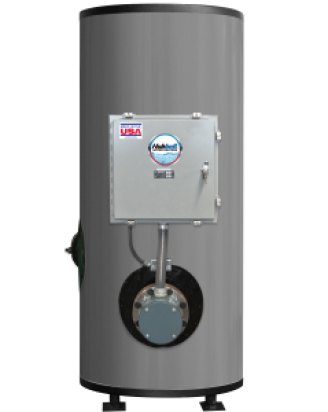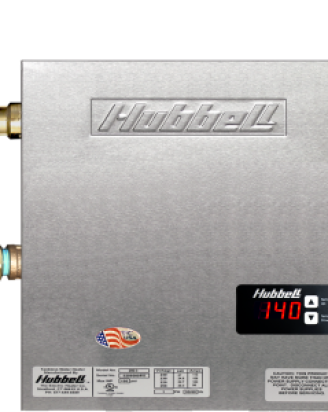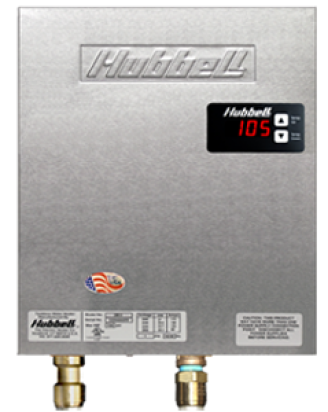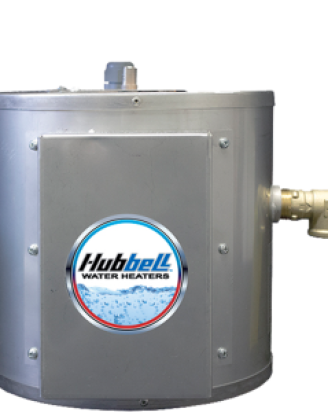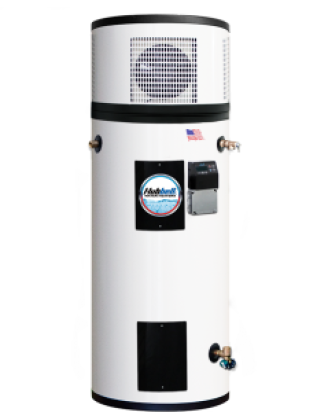
Horizontal Water Heater
Hubbell Endurance EH / SEH
19, 30, 40, 55 gallon capacity, all voltages, single or three phase
made specifically to be ceiling hung above a drop ceiling

Description
A space saving water heater that's easy to install
Today's design requirements put a premium on floor space for many commercial applications. The Hubbell HE and HSE model horizontal water heaters specifically address the concern of utilization of space by providing a horizontal water heater for installation above a drop ceiling. The integrally welded mounting assemblies are designed for quick and efficient job site installation without the need for cumbersome and expensive structural platforms. This design, in conjunction with the superior characteristics of a Hydrastone cement lined tank, gives you the confidence in knowing that when you specify and install a Hubbell water heater, the owner will be provided with a quality product that is a long lasting and trouble-free source for hot water.
Features
Space Saving Design
- Horizontal ceiling hung tank requires minimal clearance and no floor space
- Simple tie rod installation eliminates expensive and cumbersome mounting shelves
Heavy Duty Construction
- Hydrastone cement lining provides long tank life
- High impact composite jacket cannot rust or corrode and eliminates damage during transit and installation
Reliable
- Full range of sizes to meet your exact heating needs
- Immersion adjustable thermostat provides accurate temperature control
- Full five (5) or ten (10) year Non Pro-Rated tank warranty



Optional Equipment


FAQs
What temperature should I set my water heater?
For typical domestic potable hot water service the temperature of your water heater at 125°F is sufficient. This prevents wasted energy (which means cost savings for you) and also decreases the possibility of scalding water burns. If you run out of hot water on this setting, increase the temperature by five degrees incrementally until your hot water needs are met. The goal is to have the temperature set just high enough to meet your needs but within safe operating parameters. Please note that a water heater in and of itself should not be relied upon as the ultimate temperature controlling source for the hot water delivered to your fixtures. Please consult local and state codes for installation of the proper and code approved (ASSE 1016, 1070, 1017) mixing devices to achieve the safe delivery of hot water to the fixtures. For a more complete information please download the whitepaper PDF titled "Understanding Potential Water Heater Scald Hazards" developed by ASSE at the following link ASSE Whitepaper
Do I need to install an insulation blanket?
No. Most new electric water heaters are highly efficient with respect to the amount of heat loss radiating from the storage tank. This is due to the use of “blown in” polyurethane foam insulation as the insulating method for modern tanks, compared to the fiberglass blanket style insulation used by water heater manufacturer’s largely in the past. As such there is little to no benefit, and very possibly a detrimental effect to efficiency, installing an insulation blanket on a new electric water heater constructed with foam insulation.
What is the average life of an electric water heater?
The most important factor related to the life expectancy of a water heater is the quality and type of storage tank. On an average the life expectancy of a glass lined electric water heater is about 10-12 years (according to the National Association of Home Builders 2007 Study of Life Expectancy of Home Components http://www.nahb.org/fileUpload_details.aspx?contentID=99359 ), compared to a cement lined electric water heater’s average life expectancy of 23-26 years (Independent study of over 25,000 installations for an Electric Utility). Of course, there are various other factors that affect longevity including pressure fluctuations, usage, water conditions, environmental conditions, etc.
Is it OK to use softened water with my cement lined tank?
Yes it is OK. A water softener system will not affect the longevity or operation of a Hubbell cement lined water heater tank. A water softener is typically installed when a potable water system has hard water resulting in the need to soften the water. Unfortunately, the salt used in a water softener corrodes the anode rod and exposed steel surfaces of the water heater tank, rapidly causing a glass lined water heater to corrode and leak within a few years. This is an issue for a glass lined water heater due to its reliance on a sacrificial anode, however because a cement lined tank does not use a sacrificial anode softened water is of no concern to the Hubbell cement lined tank.
What is a sacrificial anode and does a cement lined tank need one?
All water heaters constructed using a steel tank requires a lining to protect the internal steel surfaces from corrosion. Certain linings (i.e. glass and epoxy), due to their nature, have unavoidable holes and imperfections resulting in exposure of the steel tank. As a result of this deficiency, the manufacturer will install an anode rod(s) in an attempt to delay corrosion of the steel tank. An anode rod is typically made of aluminum, magnesium or zinc, is a maintenance item that requires periodic inspection and replacement, and is often times the cause of a “rotten egg” odor to your hot water. Often referred to as a sacrificial anode rod because, over time, it slowly dissolves, sacrificing itself as it is attacked by aggressive substances in the water which would otherwise attack the steel tank through the pinholes and imperfections of the glass or epoxy lining. A cement lined steel tank on the other hand does not require an anode because of the thickness and guaranteed 100% coverage of the cement lining over all internal surfaces of the steel tank. This eliminates the need for an anode rod in a cement lined water heater, resulting in a significantly longer life compared to a glass or epoxy lined water heater. For a further discussion please click on the following link Cement Lining
What is the max water temperature setting?
The Hubbell cement lined tank is suitable for storing water up to 194°F. However, it should be noted that your water heater will likely require optional control accessories to achieve this temperature, but there is no concern regarding the ability of the lining to withstand this temperature. Additionally, there are numerous safety concerns that must be considered when storing water at elevated temperature, please consult factory.
Which is better for me, a tankless or storage type water heater?
It depends. A tankless water heater is sometimes referred to as a Point-of-Use (POU) or instantaneous water heater. Due to the relative small physical size of a tankless water heater compared to a storage tank water heater, a tankless option can be advantageous from a space saving perspective and can sometimes be installed closer to where you want hot water (hence the term POU). However, tankless heaters are not suited for many applications, so it is critical that before choosing to go tankless you have carefully considered all of the factors that sometimes make the tankless option more complicated and risky compared to a storage type water heater. In particular, you should understand the operational characteristics, maintenance requirements, reparability, and sometimes significant installation requirements of a tankless water heater before making a decision. Tankless units do not store heated water like a storage type water heater; they only heat water as there is demand and therefore must be sized to meet the maximum flow for the application. In some cases a tankless water heater may improve operating efficiency, but possibly at the expense of user comfort. Hubbell tankless water heaters are available inElectric Tankless or Gas Tankless.
What is the water pressure drop through the tank?
There is no major restriction of water flow through the Hubbell water heater. Cold water inlet and hot water outlet sizes are available in ¾” and 1-1/2” sizes to accommodate your application. By far, the ¾” size is more than adequate for most applications using a model E water heater. If your flow rate through the water heater is greater than approximately 10 GPM you may want to consider the 1-1/2” connection option (must be specified at time of ordering). As an approximate, pressure drop through any E model water heater with ¾” connections will be <4 psi with a flow rate of <10 GPM, and with 1-1/2” connections the pressure drop will be <3 psi with a flow rate of <20 GPM.
Do I need a drain pan under my heater?
Yes, Hubbell advises that a drip pan with a proper drainage connection be installed under your water heater. In some locations drip pans are required by code and in other situations they are highly recommended, but not required. In either case, if a water heater leak or a dripping relief valve could result in property damage then a drip pan must be installed under the water heater, even when not required by code.
Is there a cold water dip tube in the Hubbell tank?
Not exactly. The Hubbell cement lined tank includes a cold water diffuser integrated into the cold water connection which allows incoming cold water to be introduced into the tank in a controlled and non turbulent manner, thus avoiding premature mixing of cold water with the hot water in the tank. On Hubbell cement lined tanks the cold water inlet/diffuser is located on the side in the lower portion of the tank. Therefore, a Hubbell cement lined tank does not require a long dip tube extending all the way from the top to the bottom of the tank as is common in glass lined tanks.
How does my water heater ship?
All Hubbell storage type water heaters ship via common carrier and are classified by the Commodity Classification Standards Board under National Motor Freight Classification (NMFC) class 100. Each water heater is palletized and wood crated. All Hubbell tankless water heaters, when transported using common carrier, ship class 77.5. To provide the lowest transportation cost, in most cases the shipment is made on Hubbell’s account and the freight cost is added to the invoice, commonly referred to as “Pre pay and add”. For very large shipments, the most economical method (LTL or Dedicated Truck) for transporting the water heaters to the final destination will be analyzed by Hubbell's transportation department.
Why is Hydrastone Cement a better choice over glass lining?
Cement lining provides guaranteed 100% coverage with a minimum thickness of 0.5” over all internal tank surfaces. In comparison, glass lining is approximately 0.005” thick and includes imperfections, pinholes and variation in coverage thickness resulting in portions of unprotected steel tank exposed to corrosion. In an attempt to compensate, glass lined tanks include a sacrificial anode in an effort to slow down the corrosion of the tank. Cement lined tanks on the other hand do not require an anode due to the integrity of the lining. As such, a cement lined tank will far outlast a glass lined tank. For a more complete explanation of the benefits of the Hubbell cement lining please click on the following link Cement Lining
Why is a cement lined tank a better choice than stainless steel tank?
In almost all cases, a cement lined steel tank is a more robust tank compared to stainless steel. The weakness of a stainless steel tank is in the materials susceptibility to SCC (Stress Corrosion Cracking) caused by chlorides, bromides, iodides and fluorides in the water. The combination of residual stresses from welding, roll forming and stamping, and the cyclic stress from operating in a hot water system are sources of tensile stress, that when above a certain threshold stress, will make a stainless steel water heater tank susceptible to stress corrosion cracking. Cement lined steel tanks are not susceptible to this condition, and therefore are more resistant to corrosion and withstand the pressure and temperature cyclical operation of a water heater.
Is this model approved by Massachusetts?
| MA Plumbing Approval Number | Hubbell Model | Expiration Date |
|---|---|---|
| P3-0914-61 | HD, J, V, PS, SLN, T | 9/3/2017 |
| P1-1114-201 | EMV, CR, R, JTX, ETX, TX | 11/5/2017 |
| P3-0813-66 | CE110, SE, E, HE, SH, H | 8/7/2016 |
| G1-0813-4 | GX, DGX, JBX, JGX, CX | 8/7/2016 |
Is 277 volt 3 phase voltage available for a water heater?
For all water heaters 277V is only an available option in 1PH, not 3PH. The 277V 1PH voltage is a derivation of your existing 480V 3Ph power. Where 480V is the line to line voltage on a 3 phase system and 277V is the voltage from any one of these lines to neutral, thus making the 277V power available in 1PH only.
What is the R value of a Hubbell water heater?
Hubbell uses a blown-in polyurethane foam insulation for all cement lined water heaters and tanks up to 150 gallon capacity. This insulation has an R value of 7.2 per inch. Most Hubbell tanks have a minimum of 2 inches of insulation resulting in an R value of 14. Certain models are available either standard or as an option with 3 inch insulation and therefore have an R value of 21. Large storage water heater tanks over 150 gallon capacity and custom made stainless steel or alloy tanks have either 2" or 3" fiberglass insulation with an R value of 3.5 per inch.
Do Hubbell water heaters qualify as Low Lead?
Yes, all Hubbell water heater models qualify as meeting the low lead requirements of the “Reduction of Lead in Drinking Water Act” amendment to the “Safe Drinking Water Act” (SDWA) Section 1417(d) effective as of January 4, 2014. Hubbell certifies that its water heaters meet the following requirements of the SDWA and therefore are qualified and certified as Low Lead : (a)Hubbell water heater do not contain more than 0.2 percent lead with respect to solder and flux (b)Hubbell water heaters do not contain more than a weighted average of 0.25 percent lead with respect to all wetted surfaces of the water heater
Can my cement lined tank be damaged during installation and handling?
Although we don’t advocate dropping our tanks sometimes stuff happens. The Hubbell Hydrastone cement lining is a minimum of 1/2"thick (100 times thicker than a glass lined tank) and is guaranteed to uniformly cover 100% of all internal tank surfaces. Basically the Hubbell cement lining is a tank within a tank and should have no problem withstanding the rigors of shipping and installation. Although not necessry, you can specify an optional hand hole on our smaller tanks (150 gallon and under) to provide a means for inspection and repair. Water heaters with tanks larger than 36" generally include a 12" x 16" manway. In both cases, a Hubbell tank properly maintained will last decades.
What is the difference between solid-state and electromechanical relays?
Depending on the application, one switch may be more advantageous than the other. Please refer to this article to read more about the differences between solid-state and electromechanical relays.
How do I prepare my water heater for long term storage?
The water heater must be stored in the orientation of intended use (vertical, horizontal). The recommended ambient air temperature range is between 50 and 105 degree F and not exceeding 65% Rh. Under no conditions should the unit be subject to freezing temperatures. The unit is intended to be stored indoors, protected from the elements. Desiccant material should be inserted into the electric control panel and heating element terminal house (if applicable). Prolonged storage will require periodic inspection of desiccant. For cement lined tanks only, place approximately 10 gallons of water in the tank before closing and sealing all openings to ensure a humid atmosphere for the lining is maintained. Cap and seal all openings and tank tappings and/or flanges. Provide the necessary protection to ensure the tank and all accessories are protected from physical contact that could result in damage. Shrink wrapping or other suitable protective plastic may be applied to the exterior. Start up and installation guidelines must be followed, with particular attention to testing of the electric heating element.
Is a drain pan/drip tray needed for a ceiling hung water heater?
Yes. Without exception. The pan must also be connected to a suitable drain so water is properly routed to a drain.
Warranty
Hubbell shall warranty all electrical components against defects in workmanship and material for a period of one (1) year from date of start-up, and the pressure vessel for a full five (5) years Non Pro-Rated (Square Optional: Full ten (10) years Non Pro-Rated) from date of start-up, provided that the unit is started within three (3) months of shipment and installed and operated within the scope of the tank design and operating capability. Each water heater shall be shipped with a complete set of installation and operating instructions including spare parts list and approved drawings.
Technical Support
Our Technical Support Reps are ready to assist you. Please contact us today.



